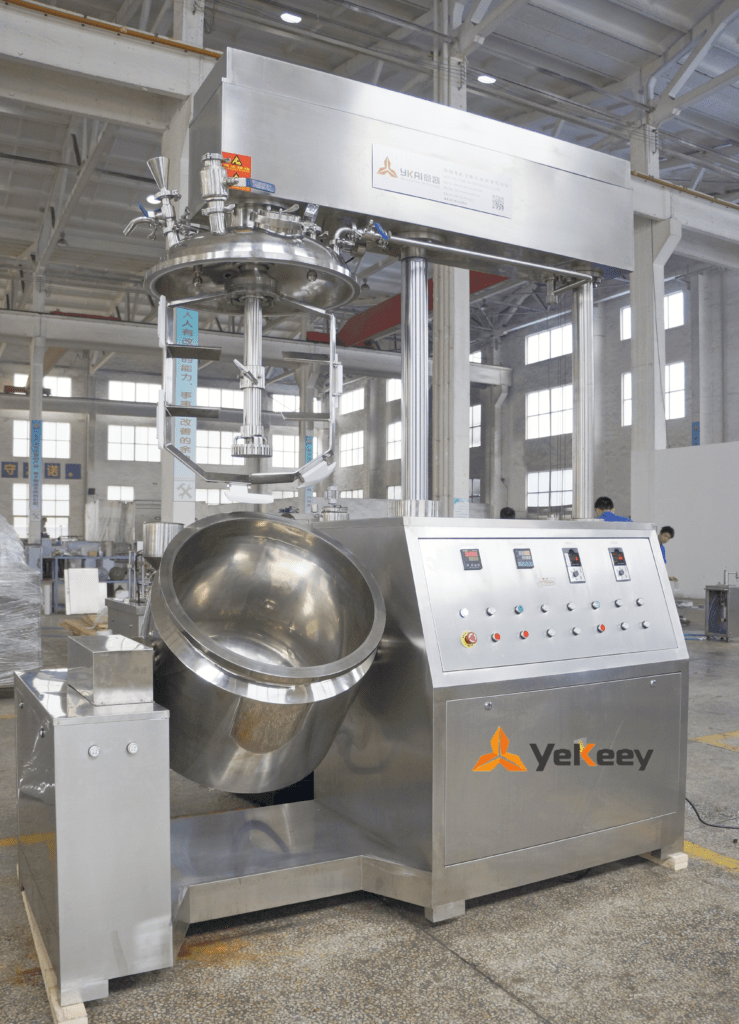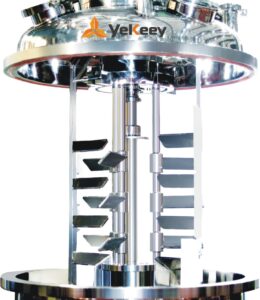-
What is a dispersion mixer?
( ) A dispersion mixer is a device used for mixing and dispersing various materials, such as liquids, solids, and gases, in order to achieve a homogeneous mixture.
(2) It typically consists of a mixer vessel, agitator, and a dispersion system.
(3) The agitator rotates inside the vessel, generating shear forces that break down larger particles or droplets into smaller ones, while the dispersion system helps distribute the materials evenly throughout the mixture.
(4) Dispersion mixers are widely used in various industries, including chemical processing, pharmaceuticals, cosmetics, food processing, and more. They can be used to mix and disperse emulsions, suspensions, solutions, and other types of mixtures.
(5) The key benefits of using a dispersion mixer include:
- Improving the uniformity and consistency of the mixture.
- Increasing the surface area of the materials, which can enhance chemical reactions or improve the properties of the final product.
- Reducing the size of particles or droplets, which can improve the stability and shelf life of the mixture.
- Enabling the production of complex mixtures that are difficult to achieve with other types of mixing equipment.
2. What is the difference between a disperser and a mixer?
The key difference between a disperser and a mixer lies in their intended use and the type of mixing process they perform.
(1) A disperser, as mentioned earlier, is primarily used to break down larger particles or droplets into smaller ones. This is achieved by applying high shear forces, typically using a high-speed agitator or rotor, to create turbulent flow and intense shear within the material. Dispersers are commonly used in industries that require the production of emulsions, suspensions, or other mixtures with fine particle size distribution, such as the chemical, pharmaceutical, and cosmetics industries.
(2) On the other hand, a mixer is designed to combine two or more ingredients together to form a homogeneous mixture. Mixers typically operate by rotating or agitating the materials within a container, using blades, paddles, or other agitators to move the materials around and promote mixing. The main objective of a mixer is to achieve a uniform distribution of ingredients, ensuring that each part of the mixture has the same composition. Mixers are widely used in various industries, including food processing, construction, and plastics manufacturing, to blend ingredients, improve product quality, and ensure consistency.
In summary, a disperser focuses on reducing the size of particles or droplets through high shear forces, while a mixer focuses on combining ingredients to form a uniform mixture.
3. What does dispersion mixer do?
Some examples of dispersion mixer applications include:
- In the pharmaceutical industry, dispersion mixer is used to create suspensions or emulsions of drugs or active ingredients, enabling better delivery and absorption by the body.
- In the cosmetics industry, dispersion mixer is employed to create emulsions or lotions with uniform particle size distribution, providing a smooth and consistent texture.
- In the food processing industry, dispersion mixer is used to mix and blend ingredients, ensuring a uniform distribution throughout the product and improving its texture, taste, and appearance.
4. What is dispersion mixer process?
The dispersion mixer process is a technique used to homogeneously distribute small particles or droplets throughout a liquid medium. This process involves the use of shear forces to break down larger particles or droplets into smaller ones, increasing the surface area and promoting better mixing.
(1) The dispersion mixer process typically occurs in three stages: wetting, deagglomeration, and stabilization.
- Wetting: In this stage, the solid particles or droplets are initially contacted with the liquid medium. The goal is to coat the particles with the liquid, reducing the interfacial tension between the solid and liquid phases. Wetting agents or surfactants may be added to aid in this process.
- Deagglomeration: Once the particles are wetted, the next stage is to break them down into smaller, individual units. This is achieved by applying shear forces, either mechanically or through the use of chemical agents. The shear forces disrupt the agglomerates and break them into smaller particles.
- Stabilization: The final stage involves stabilizing the dispersed particles to prevent reagglomeration. Stabilizers, such as emulsifiers or polymers, can be added to create a protective layer around the particles, reducing their tendency to reagglomerate.
(2) The dispersion mixer process can be carried out using various equipment, such as high speed agitators or ultrasonicators, depending on the specific requirements of the application.
(3) The resulting dispersion typically exhibits improved physical properties, such as increased solubility, reactivity, and stability. It also allows for the uniform distribution of active ingredients or particles throughout the liquid medium, which is crucial in many industrial applications.









What’s up, after reading this remarkable piece of writing i am also cheerful to share my knowledge here with mates.
Thank you for the auspicious writeup It in fact was a amusement account it Look advanced to far added agreeable from you However how can we communicate
Please leave your thoughts directly and I will communicate with you in the comments section.